Hello! I’m Michael Zhang, an avid traveler with extensive international experience. I’m passionate about exploring diverse cultures and histories and uncovering unique stories from every destination. This guide will take you through the enchanting Yu Garden in Shanghai, revealing its architecture, history, and culinary highlights. I hope my insights help you better appreciate Yu Garden, enriching your visit to Shanghai.
Summary
About Yu Garden
Yu Garden, established over 450 years ago during the Ming Dynasty (Jiajing and Wanli periods), spans more than 30 acres. This classical garden is one of the “Three Great Gardens of the Ming Dynasty in Shanghai” and stands as one of Shanghai’s top five classical gardens. Yu Garden was originally a private garden created by Pan Yunduan, a Sichuan governor, for his father, Pan En, a retired government official. After over 20 years of careful design and landscaping, Yu Garden became known as the “crown of eastern gardens.” Today, the garden embodies traditional southern Chinese design, showcasing the “elegant and refined” style of the Ming and Qing periods. Within, you’ll find preserved ancient trees, Ming and Qing-era furniture, famous calligraphy, pottery sculptures, and intricate brick carvings—a true showcase of traditional Chinese artistry.
- Address: 168 Fangyou Rd., Huangpu District, Shanghai (Apple Maps/Amap)
- Opening Hours: 9:00—16:30 (last entry at 16:00); closed on Mondays (except for public holidays). During Chinese New Year, hours may vary.
- Recommended Visit Duration: 1 hour
- Ticket Prices: 40 RMB
- Ticket Purchase: Trip.com Discounts, Klook Deals, KKday Offers
- Compare ticket prices and find the best deals: Click Here
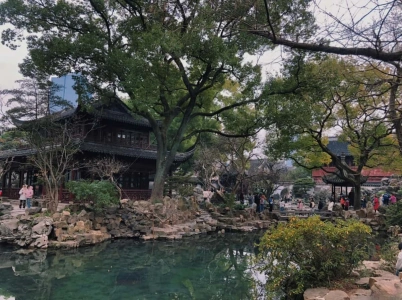
Yu Garden Map
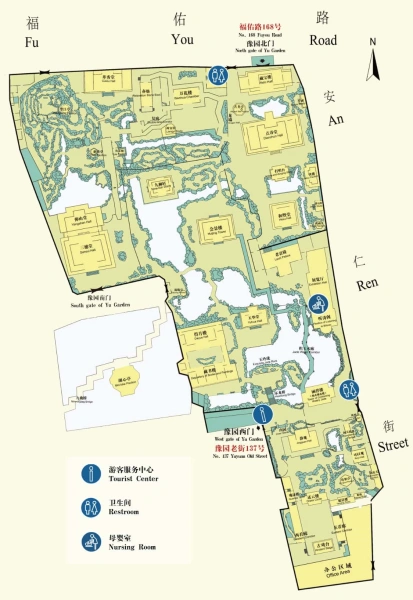
Key Sights in Yu Garden
Huxinting Teahouse
Known as the “First Teahouse of Shanghai,” Huxinting Teahouse is one of the city’s oldest and most celebrated teahouses, located centrally within Yu Garden. Connected by the iconic zig-zag bridge, this teahouse offers an ambiance that blends historic charm with authentic Chinese tea culture. Its traditional Ming-Qing architectural style makes it a cultural landmark, linking Shanghai’s historical identity with modern urban life.
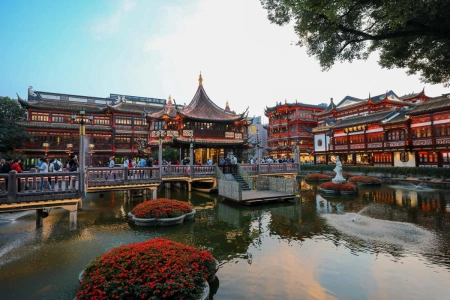
Sansui Hall
Sansui Hall is located in the northeastern section of Yu Garden. Originally named Leshou Hall and built in 1760, its name signifies “Happiness and Longevity.” During the early Qing Dynasty, Sansui Hall served as Shanghai’s county government office, symbolizing hopes for success and prosperity. By the late Qing period, it was transformed into a bean and rice trade center, earning it the nickname “Weighing Pavilion.”
Visitors will find numerous sculptures here with symbolic meanings of ambition and success. For example, the brick carvings at the entrance hall showcase “Wu Ju Deyuan,” a design intended to encourage the pursuit of fame and service to the nation. The hall also features auspicious carvings on structures like the roofline of Juan Rain Tower. The floral carvings on the roof of Sansui Hall symbolize longevity and prosperity, while the designs of elephants bearing plants on Juan Rain Tower embody wishes for peace and good fortune, as “elephant” and “auspicious” share a similar pronunciation in Chinese.
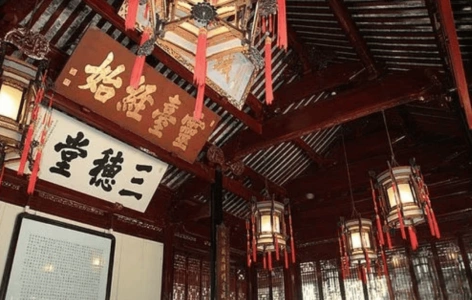
Wanhua Tower
Wanhua Tower, found in the northern area of Yu Garden, is renowned for its ornate decorations and thoughtfully designed spaces that inspire reflection and imagination. This structure was rebuilt in 1843 and once bore the name “Shenchi Hall,” meaning “Hall of Divine Measure.” After the founding of modern China, the name was changed to Wanhua Tower, which can be interpreted as “within the thousands of flowers,” reflecting the original builder Pan Yunduan’s vision.
Wanhua Tower displays numerous sculptures of the Eight Immortals, characters from Chinese folklore symbolizing the desire to connect with nature and pursue a divine lifestyle. These decorations are in harmony with the ideals of the tower’s late-Qing name, encouraging visitors to practice kindness and seek enlightenment. Other prominent carvings include the “Fisherman, Woodcutter, Farmer, and Scholar” on the east side of Liangyi Pavilion. This design represents the simple lifestyle cherished by ancient Chinese, reflecting a desire for peace and a retreat from worldly ambitions.
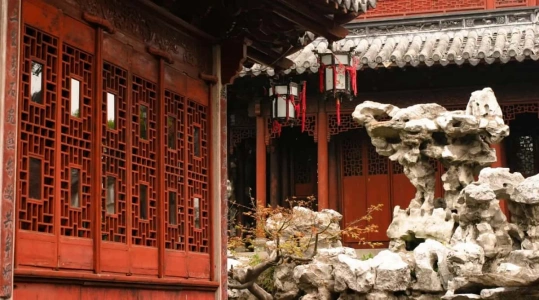
Dianchun Hall
Dianchun Hall is centered around the main Dianchun structure, named after the poet Su Dongpo’s phrase “Spring in All Its Splendor.” Historically, this space was reserved for family gatherings during festivals. In front of the hall, you’ll find a small theater called the “Singing Platform,” where intricate carvings reflect the folk culture of the Ming and Qing periods. Most of these carvings, spread across the structures in Dianchun Hall, feature protective symbols designed to repel evil spirits. There are as many as 15 of these “Tile Generals” scattered on rooftops, symbolizing guardianship. Among them, military generals like Guan Yu and Lü Bu from the Three Kingdoms period are the most recognizable. Civil officials also appear, symbolizing success in civil service examinations and career advancement.
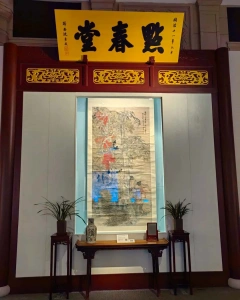
Yu Garden Ticket Guide
Ticket Prices
- Peak Season (April-June, September-November): Adult ticket ¥40
- Off-Peak Season (July-August, December-March): Adult ticket ¥30
- Discounted Tickets: Children (ages 6-18) and seniors (ages 60+): ¥20 during peak season, ¥15 off-peak
- Free Entry: Children 6 years and under or under 1.3 meters tall enter free, with an accompanying adult (one adult may bring up to three children).
Where to Purchase Tickets
- On-site Purchase: Tickets can be purchased at both the south and north entrances of Yu Garden.
- Online Purchase: For a more convenient experience, visitors can purchase tickets online through the official platform or trusted travel websites.
- Ticket Purchase: Trip.com Discounts, Klook Deals, KKday Offers
- Compare ticket prices and find the best deals: Click Here
Guide Services in Yu Garden
Local Travel Agencies:
There are no official guide services within Yu Garden, but visitors may book a guide through local travel agencies.
Online Guide Booking:
To enhance your experience, you can book a guide online in advance. Many platforms offer licensed guides who provide detailed insights into Yu Garden’s history and culture.

Suggested Route for Yu Garden and City God Temple
Starting at Yuyuan Metro Station (Exit 1), visit Fuyou Small Goods Market, then proceed to the South Gate and West Gate of Yu Garden. Explore Nine-Bend Bridge, Huxinting Teahouse, Yixiu Pavilion, Chocolate Museum, Shanghai Opera Teahouse, City God Temple, and Yuyuan Bazaar.
Getting to Yu Garden from Downtown Shanghai
- By Metro: Take Metro Line 10 to Yuyuan Station and exit at Exit 1.
- Transportation Card Purchase: Trip.com Discounts, Klook Deals, KKday Offers
- By Bus: Bus routes 930 and 64 stop at Xinbeimen Station, close to the garden.
- By Sightseeing Bus: Shanghai’s sightseeing buses (Lines 1, 3, and 5) also stop at Yuyuan.
Recommended Local Foods Near Yu Garden and City God Temple
- Five-Spice Beans: A crunchy snack with a unique blend of spices, found at the City God Temple.
- Pear Syrup Candy: Known for its soothing effect, this traditional Shanghai treat is famous for its unique taste.
- Butterfly Pastries: Crisp and mildly sweet, these pastries are a popular Shanghai dessert.
- White Rabbit Candy: A classic Shanghai candy with a rich, creamy taste and smooth texture.
- Four-Treasure Kao Fu: A signature dish from Gong De Lin, featuring a delicious combination of flavors and textures.
FAQ
What are the ticket prices for children?
Children ages 6-18 have discounted tickets at ¥20 during peak season and ¥15 during the off-peak season. Entry is free for children 6 years and under or under 1.3 meters tall.
Can I bring a stroller into Yu Garden?
Due to narrow paths and uneven terrain, strollers can be challenging to maneuver inside Yu Garden. We recommend using a baby carrier instead.
Is photography allowed inside Yu Garden?
Yes, photography is permitted in most areas of Yu Garden. However, drones are prohibited to protect the historical surroundings.
Are there places to sit and relax within the garden?
Several rest areas and seating spots are available within Yu Garden, including the popular Huxinting Teahouse, where you can enjoy a cup of tea and the scenic views.
Essential Shanghai Travel Resources
- Comprehensive Shanghai Travel Guide 📖
- Shanghai Travel Recommendations 🏙️
- Hotel Recommendations 🏨
- Transportation Guides ✈️ 🚇 🚄 🚆
- Essential Travel Tips and Tools 🗺️ 🍜 📱 💸 🌤️ 💊🛍️🔌📶🧳

 English (US)
English (US)  English (Hong Kong)
English (Hong Kong)  English (Malaysia)
English (Malaysia)  English (Singapore)
English (Singapore)  繁體中文
繁體中文 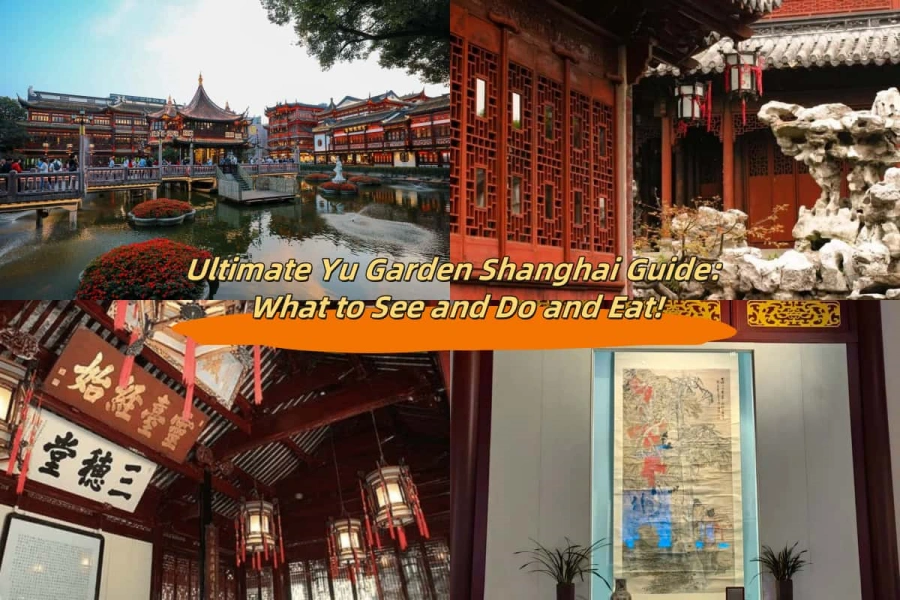
Comment (0)